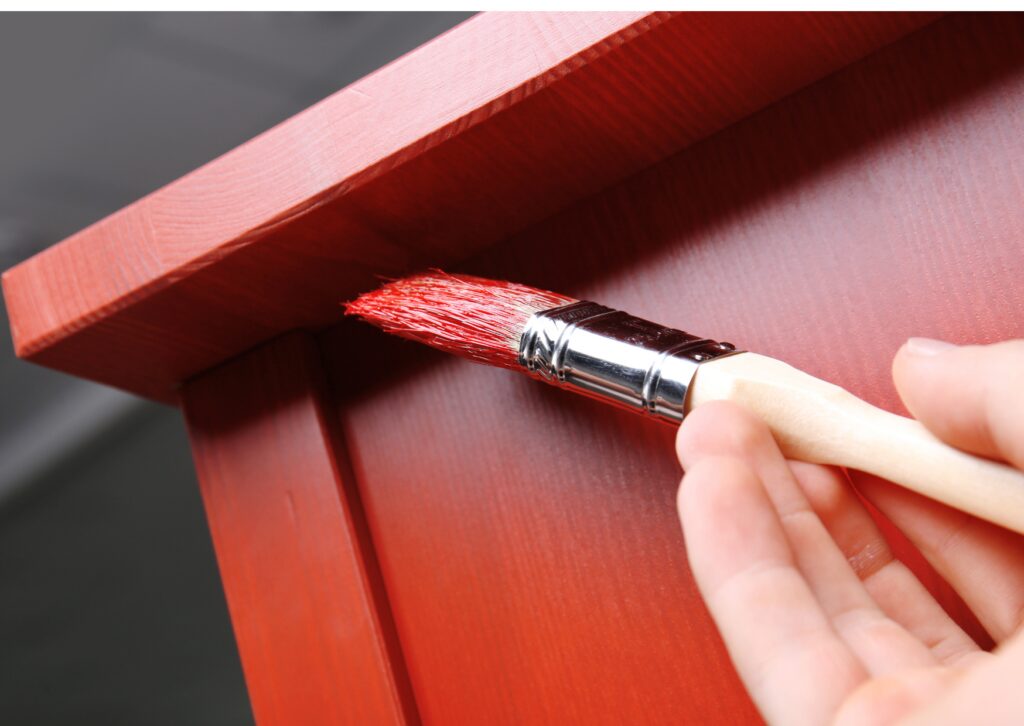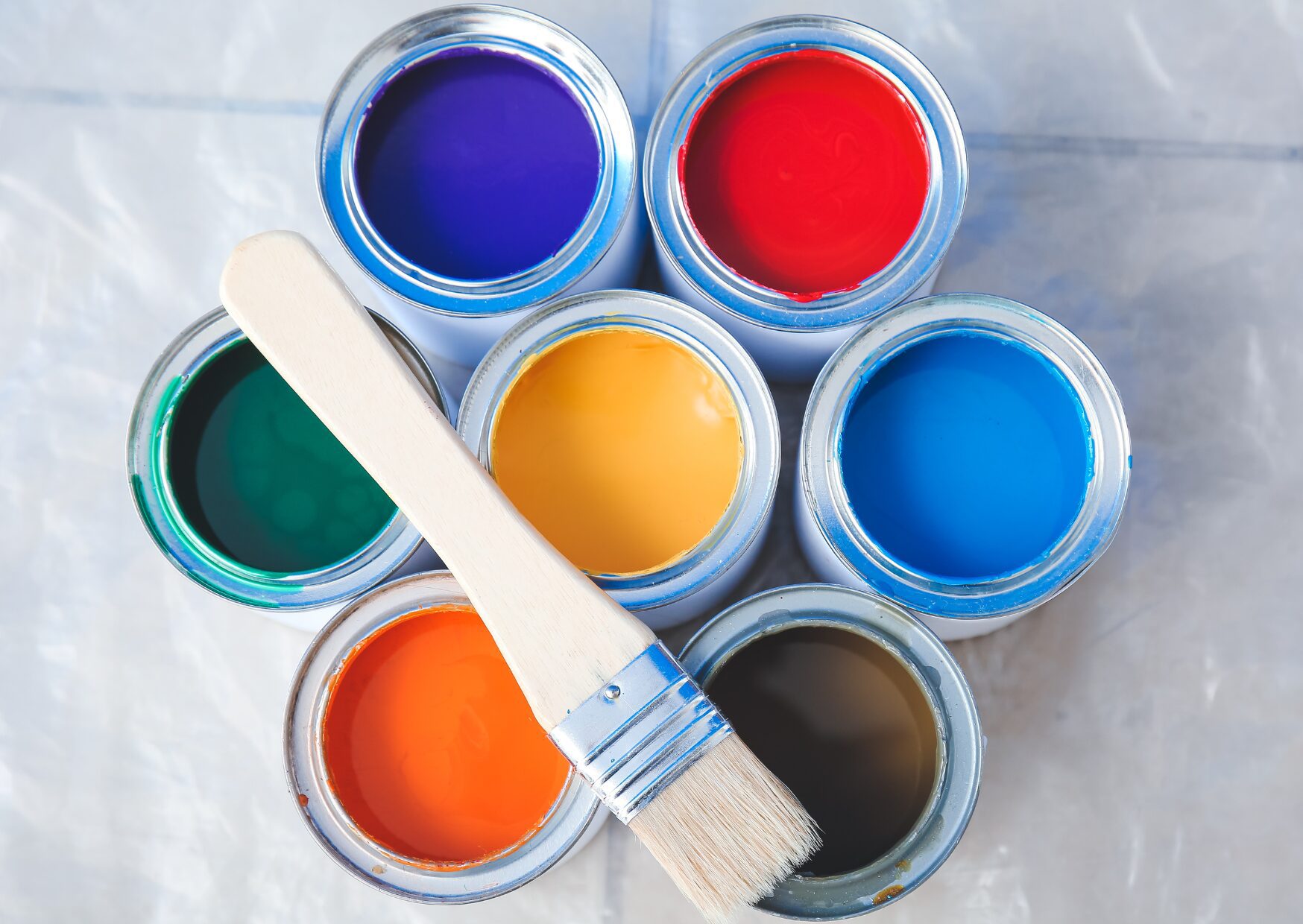Oil-Based Paint for Wood: Why It’s a Better Option Than Latex Paint – M&E Painting & Roofing
Painting your wooden surfaces like furniture or doors can give them a refreshed and new look. The type of paint to choose can significantly impact the outcome and durability of the paint job. Oil-based paints have been traditionally used for wooden structures, while latex paints are more popular in recent times. In this blog post, we will discuss why oil-based paint is a better option for wood than latex paint. Wood paint encompasses a broad category that includes oil-based paint among other types, emphasizing the importance of choosing the right type for wood projects to ensure the best results and durability.
1. Better Durability:

When it comes to enhancing the durability of paint applications on wood furniture, oil-based paint is the clear winner. Wood furniture requires a sturdy, long-lasting paint application, but latex paint may not always provide the protection needed to endure high-traffic areas. Unlike latex paint, oil-based paint forms a tough, hard surface that ensures long-lasting durability with resistance to chipping, scuffing, and other forms of wear and tear, making it an excellent choice for paint furniture projects. In the end, the superior adhesion and long-lasting capabilities of oil-based paint make it the better choice for painting wood surfaces, especially when considering the durability needed for wood furniture.
2. Superior Finishing with Furniture Paint:

Superior finishing is an essential aspect of any painting project. When it comes to achieving a smooth and glossy finish, oil-based paints are unmatched by their latex counterparts. Not only do they provide a more attractive finish, but they also ensure an even application without the need for a top coat. For those looking for an alternative that provides a matte finish and requires little to no prep work, chalk paint, including brands like Annie Sloan Chalk Paint and BB Frosch, offers a unique option. Another significant advantage of oil-based paint is its ability to penetrate deeper into the wood surface, effectively covering any stains or marks. General Finishes Milk Paint is a popular acrylic-based option suitable for both interior and exterior use, known for its low-VOC, durability, and excellent coverage. On the other hand, latex paint sits on the surface, leaving underlying flaws visibly evident. Therefore, if you want a top-quality finish that lasts, oil-based paint is undoubtedly the way to go. Among the attractive finishes that can be achieved with oil-based paint on wood surfaces is semi gloss, offering a balance between shininess and durability that is often preferred for its aesthetic appeal and ease of cleaning.
3. Excellent Coverage with Acrylic Paint:

When it comes to achieving excellent coverage in your painting projects, oil-based paint is the way to go. Additionally, water-based paint is known for its ease of application and environmental friendliness, making it a great choice for those looking to combine efficiency with eco-conscious practices. Unlike latex, which can require multiple coats to achieve the desired result, oil-based paint typically provides the coverage you need in just one layer. This not only saves you time but also ensures a smooth, even finish that will stand the test of time. Whether you’re a professional painter or a DIY enthusiast, opting for oil-based paint can help you achieve the best possible results with ease. It’s important to select the right paint to use for different wood furniture projects for optimal coverage, considering the durability and desired finish.
4. Resists Mildew, Moisture, and Heat:

Before choosing a type of paint for a surface, it’s crucial to consider the environmental factors that will affect its protection. Oil-based paint is the greatest choice if you want long-lasting paint that can tolerate heat, moisture, and mildew. This kind of paint is best suited for outdoor projects because it won’t corrode painted surfaces. Contrarily, latex paint offers a lower amount of protection and may cause unattractive bubbles, cracks, or peeling. Choosing oil-based paint may help ensure that your project looks fantastic and stays in outstanding condition for years to come, whether you are a professional painter or a DIY enthusiast.
5. Longevity:

Choosing the right kind of paint when painting furniture is essential to ensure longevity and maintain the desired finish over time. Various types of paints, including oil-based, latex, water-based, chalk paint, and acrylic paint, offer different benefits in terms of durability, ease of use, availability, and specific application areas for furniture projects. Spray paint is also a convenient option for certain furniture painting projects, offering ease of use and a variety of finishes, such as regular spray paint and spray lacquer, suitable for materials like plastic outdoor chairs.
Achieving longevity in painted surfaces requires the right paint formulation and proper application techniques. When comparing oil and latex paints, it’s important to note that oil-based paints have a distinct advantage in their ability to endure over time. With the appropriate topcoat, surfaces painted with oil-based paint maintain their original appearance for years without suffering from the fading or cracking commonly associated with latex paint. As painting professionals, it’s crucial that we consider the long-term performance of the materials we select to ensure our client’s satisfaction and preservation of their desired aesthetic.
As a result of its higher adherence, increased durability, glossy finish, superior coverage, and resistance to mildew, moisture, and heat, oil-based paint is a preferable choice when painting wood. Even while it takes longer to dry, the advantages outweigh the inconvenience. When choosing paint, keep in mind to take into account the kind of wood and the finish you want to achieve, as well as your level of expertise, the paint’s effect on the environment, and its toxicity.
FAQ: Why Oil-Based Paint is a Better Option for Wood Than Latex Paint
1. What are the main advantages of using oil-based paint for wood furniture?
Oil-based paint offers superior durability, better adhesion, a smoother and glossier finish, excellent coverage, and resistance to moisture, mildew, and heat. These benefits make it ideal for painting furniture and other wood surfaces.
2. How does oil-based paint improve the durability of wood surfaces?
Oil-based paint forms a tough, hard surface that resists chipping, scuffing, and other forms of wear and tear. This makes it perfect for high-traffic areas, ensuring long-lasting protection for wood furniture.
3. Why is oil-based paint considered to have a superior finish compared to latex paint?
Oil-based paint provides a smooth, glossy finish that covers stains and marks effectively. It penetrates deeper into the wood surface, ensuring an even application without visible underlying flaws, making it ideal for achieving the best results on wood.
4. How does oil-based paint achieve better coverage with fewer coats?
Oil-based paint typically provides the desired coverage in just one layer, saving time and ensuring a smooth, even finish. In contrast, latex paint often requires multiple coats to achieve similar results, making oil-based paint more efficient for painting projects.
5. Why is oil-based paint better suited for environments with high humidity and temperature variations?
Oil-based paint resists mildew, moisture, and heat, making it ideal for exterior wood projects. It prevents unattractive bubbles, cracks, or peeling that latex paint might develop in such conditions, ensuring the longevity of the paint job.
6. Can oil-based paint help maintain the longevity of painted wood surfaces?
Yes, oil-based paint maintains its original appearance for years with minimal fading or cracking. Proper application, including applying primer or priming the wood surface and applying a topcoat, can further enhance its long-term performance and durability.
7. Is oil-based paint more challenging to apply than latex paint?
Oil-based paint takes longer to dry and requires proper ventilation due to its higher levels of VOCs (volatile organic compounds). However, the benefits, including durability and finish quality, often outweigh these challenges. Using the right brush and following the correct application process can help achieve fantastic results.
8. Are there any alternatives to oil-based paint that also offer good results on wood?
While oil-based paint is excellent for durability and finish, other options like acrylic paints and water-based paints can also be effective, depending on the specific project requirements and desired finish. These alternatives may have lower VOCs and faster drying times, making them suitable for interior projects.
9. What should I consider when choosing between oil-based and latex paint for wood projects?
Consider the type of wood, the desired finish, your level of expertise, environmental impact, and toxicity. Oil-based paint is generally preferred for its superior performance on wood surfaces, especially for exterior wood and high-traffic areas. However, water-based paints and latex paints can be suitable for less demanding applications.
10. How does oil-based paint compare to latex paint in terms of environmental impact?
Oil-based paints have higher VOC levels, which can be harmful to the environment and require proper ventilation during application. These alternatives may have lower VOCs, but they may not offer the same level of durability and finish quality on wood. It’s essential to weigh the environmental impact against the performance benefits when selecting the right paint for your project.